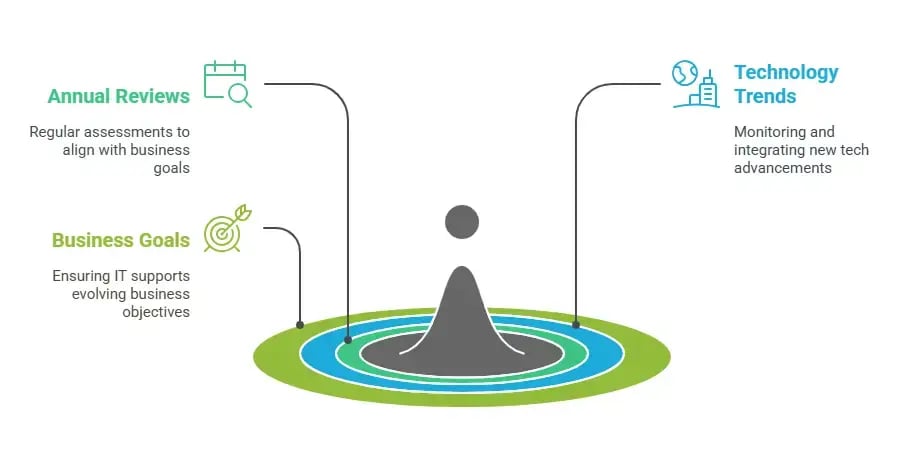
Why Every Business Needs a Strong IT Business Strategy
By Scott Putman
Technology is more than just a support system, it’s the driving force behind business growth, efficiency, and competitive advantage. Companies that embrace IT strategically don’t just survive; they thrive.
Jason Stitt, Co-Founder of IT Force, puts it simply: “Without a solid IT business strategy, companies risk falling behind in a rapidly advancing digital landscape.”
The numbers tell a compelling story—global spending on digital transformation is expected to hit $4 trillion by 2027, underscoring the increasing reliance on IT to shape business success. From cybersecurity and cloud adoption to automation and AI-driven decision-making, IT strategies are now essential.
To stay ahead, businesses must align their technology investments with their long-term goals.
In this blog, we’ll break down the key components of an effective IT business strategy and provide actionable insights to help you leverage technology for sustained growth and success.
Build a Smarter IT Business Strategy with Confidence
Partner with IT Force to align your technology with your business goals.
Learn MoreThe Core Elements of an IT Business Strategy
Creating a business IT strategy starts with understanding its key components. A strong IT strategy goes beyond just the technology. It should act as a bridge between your IT infrastructure and your company’s goals.
What is an IT Strategy?
An IT strategy outlines how technology will help meet business objectives. It includes the planning, budgeting, and execution of technology projects. But it’s not just about making things work, it’s about how IT can create value for your business.
Your IT business strategy should reflect the unique needs of your company and help you achieve your long-term vision. This strategy helps ensure that your business stays competitive and adaptable. Without a well-thought-out plan, your IT systems might fall short, leaving your business vulnerable.
To succeed, your IT strategy needs to align with your business objectives. It should improve processes, increase efficiency, and ensure that every technology decision aligns with where your business is headed.
Assessing Your Current IT Landscape
Before creating your IT strategy for business, you must take a step back and evaluate where you stand.
The Importance of a SWOT Analysis
To assess your IT business strategy's effectiveness, start by conducting a SWOT analysis of your current IT landscape.
A SWOT analysis evaluates:
- Strengths: What are your existing IT strengths? Do you have a skilled team or reliable infrastructure?
- Weaknesses: Are there areas that need improvement? Outdated systems or security gaps?
- Opportunities: What new technologies can you implement to streamline operations?
- Threats: What risks does your business face from emerging technologies or competitors?
Evaluating these factors helps you identify what’s working and what needs attention. For example, if you lack automated processes, that’s an area to address. Gaps in data security are another common problem that many businesses face.
A thorough analysis helps you figure out your starting point and shows you what needs to be done to reach your goals.
Setting Clear Objectives for Your IT Strategy for Business
Once you understand your current IT state, it’s time to set clear objectives. These objectives will guide your strategy and help you measure success.
The Power of Clear, Measurable Goals
When you create an IT business strategy, you need to be clear about what you want to achieve. Don’t just focus on technology. Think about how IT can help you reach broader business goals.
For example:
- Increase Efficiency: Can your IT infrastructure streamline workflows?
- Drive Growth: What role can IT play in supporting new products, services, or markets?
- Improve Customer Experience: How can technology enhance customer interactions?
It’s also important to measure progress. Establish key performance indicators (KPIs) for each goal, such as system uptime, response time, or customer satisfaction rates.
These metrics give you tangible data to track your progress.
Building a Flexible and Scalable IT Strategy
A successful business IT strategy needs to be flexible and scalable. The digital world is always changing. You need an IT strategy that can adapt to new technologies and growing business demands.
Adapting to Technological Change
Flexibility in your IT strategy is key to ensuring long-term success. As new technologies emerge, your IT strategy should be able to incorporate them.
For example, as businesses increasingly move toward cloud computing, your IT plan should include scalability to handle that transition smoothly.
Scalability for Growth
Your IT strategy should be able to grow with your company. Whether you’re expanding into new markets or launching a new product, your IT infrastructure should support this growth. A scalable IT strategy ensures that your systems won’t break as your company expands
Creating a Roadmap for IT Implementation
With your strategy in place, the next step is to map out a clear, actionable plan. An IT roadmap helps you break down complex initiatives into manageable steps.
Turning Strategy into Action
Your IT roadmap should include the following elements:
- Prioritized Projects: Decide which IT projects should come first. For example, if you’re improving cybersecurity, that’s a high priority.
- Timelines: Set realistic timelines for each project. Be sure to account for unexpected delays.
- Resource Allocation: Allocate the right resources, both human and financial, where needed.
Remember, a roadmap isn’t just about tasks. It’s about having each project align with your business objectives.
|
More articles you might like: |
Ensuring Effective IT Governance and Management
For your IT business strategy to succeed, strong governance is a must. Governance ensures that every participant executes your IT projects correctly in alignment with company goals.
The Role of IT Governance
A well-structured governance model ensures accountability, efficient decision-making, and project success. It outlines roles, responsibilities, and processes for overseeing your IT strategy initiatives.
Some key components of IT governance include:
- Accountability: Who’s responsible for making sure projects stay on track?
- Risk Management: How do you manage security and operational risks?
- Compliance: What regulations or standards does your business need to follow?
Without proper governance, projects can fail, timelines can slip, and goals might not be met. A clear governance structure helps prevent these issues.
Adapting and Updating Your IT Business Strategy

A business IT strategy isn’t something you set and forget. It’s an ongoing process that needs regular reviews and updates.
The Need for Continuous Evaluation
Your IT strategy should evolve as your business needs change. Technology trends shift, and market conditions fluctuate. Regularly evaluating your strategy helps you stay on top of these changes. This ongoing process ensures that your IT efforts remain aligned with the broader business objectives.
Best Practices for Strategy Updates:
- Conduct annual reviews of your IT strategy.
- Assess new technology trends and how they impact your business.
- Ensure that new business goals are reflected in the IT strategy.
Future IT Planning
After creating your IT strategy, you’ll need to plan for future projects and ensure resources are properly allocated.
The table below shows some typical priorities for businesses to consider when implementing their IT strategy:
|
Priority Area |
Key Focus |
Action Plan |
|
Cybersecurity |
Protecting data |
Implement updated security protocols |
|
Cloud Computing |
Scalability |
Migrate essential functions to the cloud |
|
Automation |
Efficiency |
Introduce workflow automation tools |
|
Infrastructure Modernization |
Flexibility |
Upgrade hardware and software |
|
Customer Experience |
User satisfaction |
Enhance customer-facing tech systems |
Synergize with IT Force to Create an IT Strategy That Propells Your Business Forward
Creating a business IT strategy is essential for aligning technology with your business goals. It ensures your IT infrastructure supports growth, drives efficiency, and enhances customer experience.
With the right planning, your IT strategy can guide you to success.
IT Force is a leading provider of IT Consulting services. Our 10.79 years average client retention and 99.48% CSAT rating in the last 12 months attest to the value we bring to help businesses meet their goals and grow.
|
Trusted Managed IT Services Near You |





